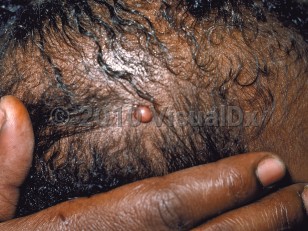Juvenile xanthogranuloma in Adult
See also in: External and Internal Eye,Hair and ScalpAlerts and Notices
Important News & Links
Synopsis

Juvenile xanthogranulomas (JXG) are benign, spontaneously regressing histiocytic tumors of unknown pathogenesis. The incidence is unknown, and there may be a slight male preponderance.
JXGs are usually solitary and most often appear at birth or within the first year of life. However, their number and size may increase over the first 18 months of life. Lesions usually regress spontaneously over 3-6 years, leaving behind persistent pigmentary change or atrophy.
Systemic involvement is rare, with the most common site of extracutaneous involvement being the eye (0.3%-0.5%). Eye involvement is more common in patients with multiple JXGs. Many internal organs can potentially be involved, including the central nervous system, liver, lungs, muscles, oropharynx, and spleen. Cutaneous lesions are absent in one-half of cases with systemic involvement. JXG lesions are primarily driven by kinase-activating alterations in mitogen-activated protein kinase (MAPK). ALK translocations and BRAFV600E mutations have been detected in some patients with systemic JXG.
JXGs have been associated with neurofibromatosis type 1 (NF1), particularly in patients younger than 2 years of age. Additionally, a triple association between JXGs, NF1, and juvenile myelomonocytic leukemia has been observed in several case reports.
JXGs can rarely occur in adults. Adult-onset xanthogranulomas persist longer and are more frequently associated with permanent changes in pigment and atrophy after spontaneous resolution.
JXGs are usually solitary and most often appear at birth or within the first year of life. However, their number and size may increase over the first 18 months of life. Lesions usually regress spontaneously over 3-6 years, leaving behind persistent pigmentary change or atrophy.
Systemic involvement is rare, with the most common site of extracutaneous involvement being the eye (0.3%-0.5%). Eye involvement is more common in patients with multiple JXGs. Many internal organs can potentially be involved, including the central nervous system, liver, lungs, muscles, oropharynx, and spleen. Cutaneous lesions are absent in one-half of cases with systemic involvement. JXG lesions are primarily driven by kinase-activating alterations in mitogen-activated protein kinase (MAPK). ALK translocations and BRAFV600E mutations have been detected in some patients with systemic JXG.
JXGs have been associated with neurofibromatosis type 1 (NF1), particularly in patients younger than 2 years of age. Additionally, a triple association between JXGs, NF1, and juvenile myelomonocytic leukemia has been observed in several case reports.
JXGs can rarely occur in adults. Adult-onset xanthogranulomas persist longer and are more frequently associated with permanent changes in pigment and atrophy after spontaneous resolution.
Codes
ICD10CM:
D76.3 – Other histiocytosis syndromes
SNOMEDCT:
400031009 – Juvenile xanthogranuloma
D76.3 – Other histiocytosis syndromes
SNOMEDCT:
400031009 – Juvenile xanthogranuloma
Look For
Subscription Required
Diagnostic Pearls
Subscription Required
Differential Diagnosis & Pitfalls

To perform a comparison, select diagnoses from the classic differential
Subscription Required
Best Tests
Subscription Required
Management Pearls
Subscription Required
Therapy
Subscription Required
References
Subscription Required
Last Reviewed:09/22/2025
Last Updated:09/22/2025
Last Updated:09/22/2025
Juvenile xanthogranuloma in Adult
See also in: External and Internal Eye,Hair and Scalp
